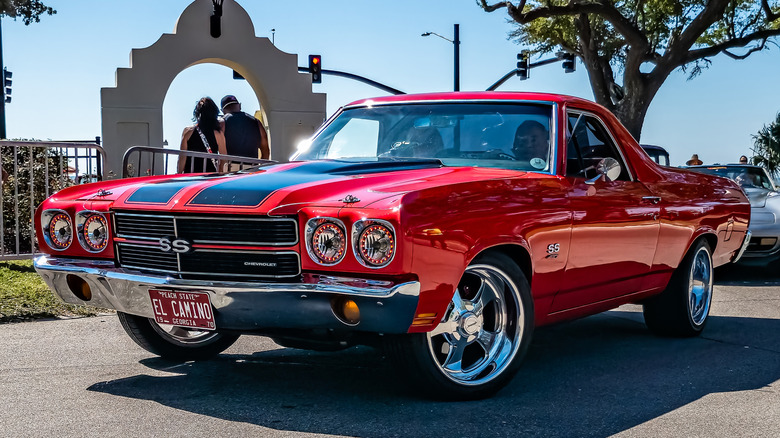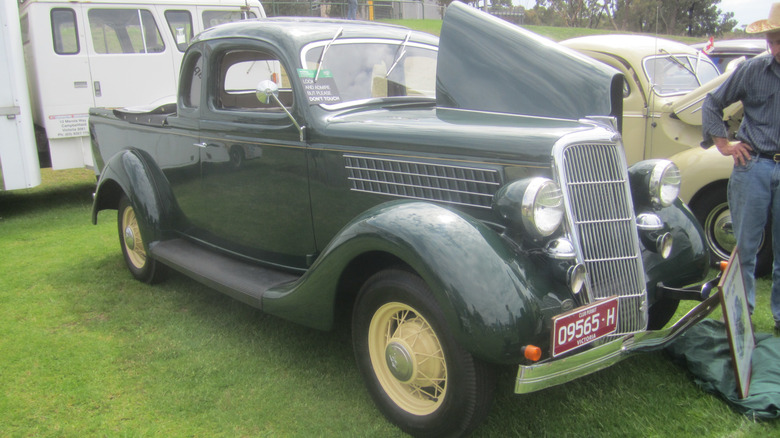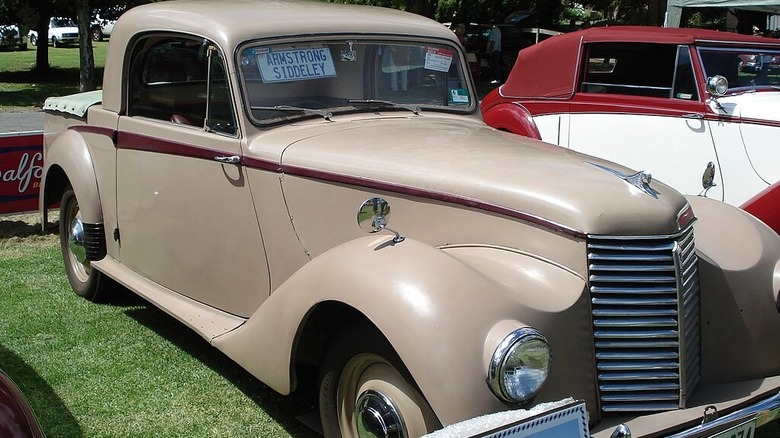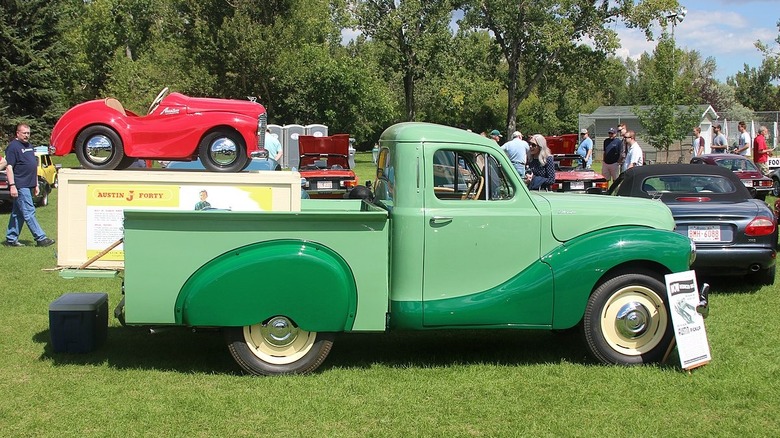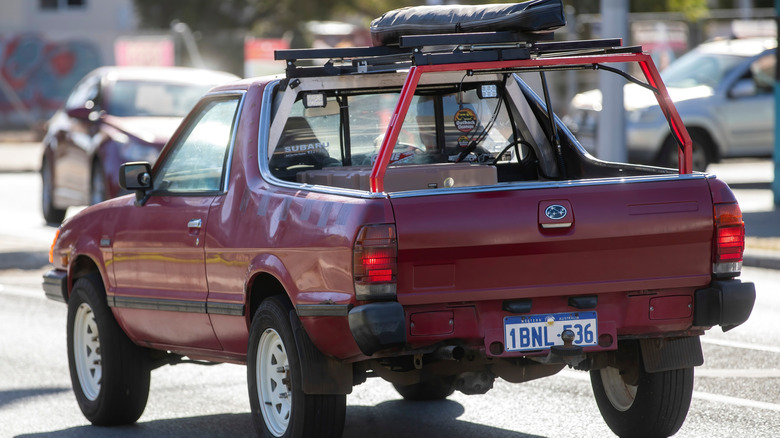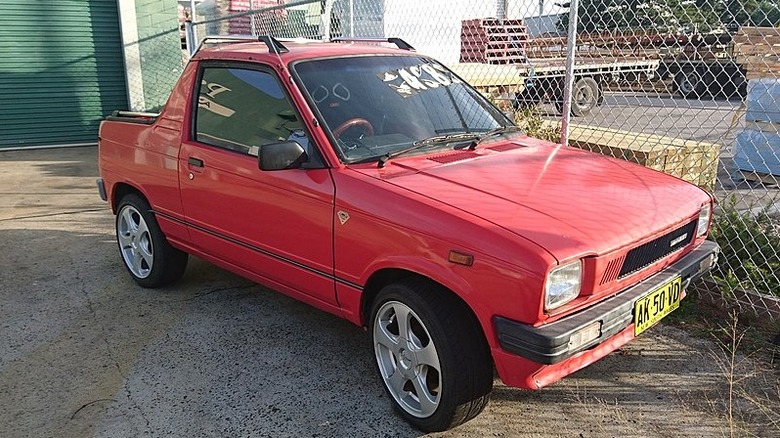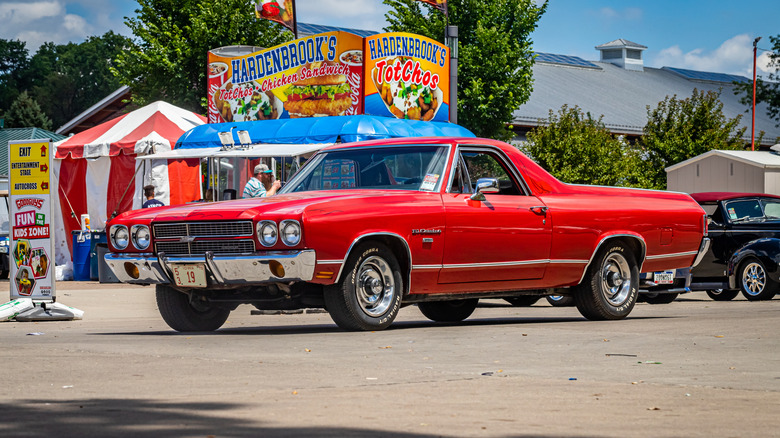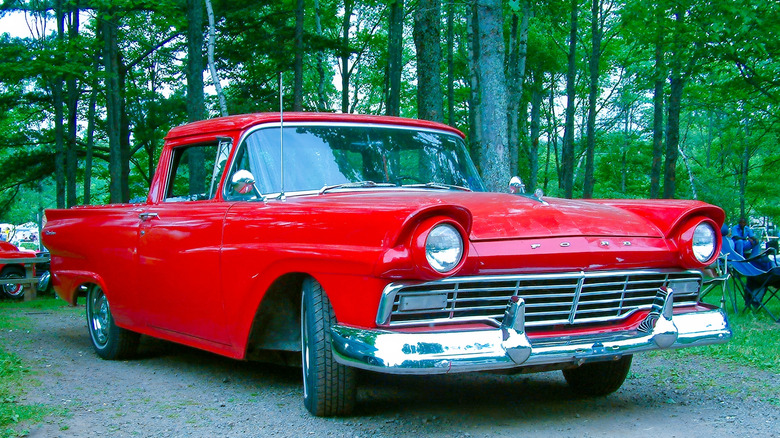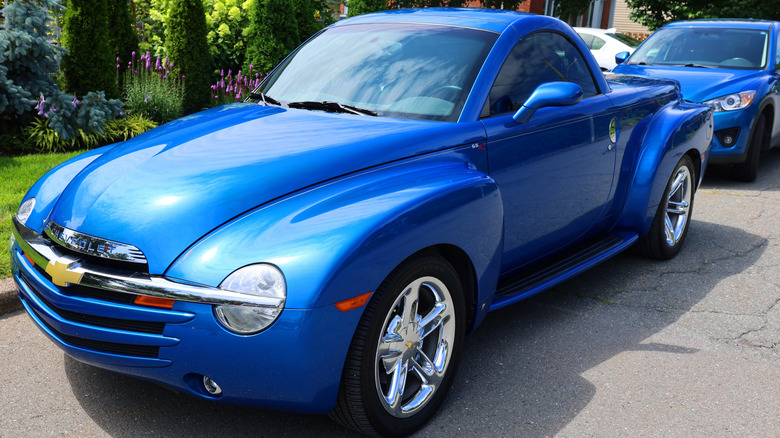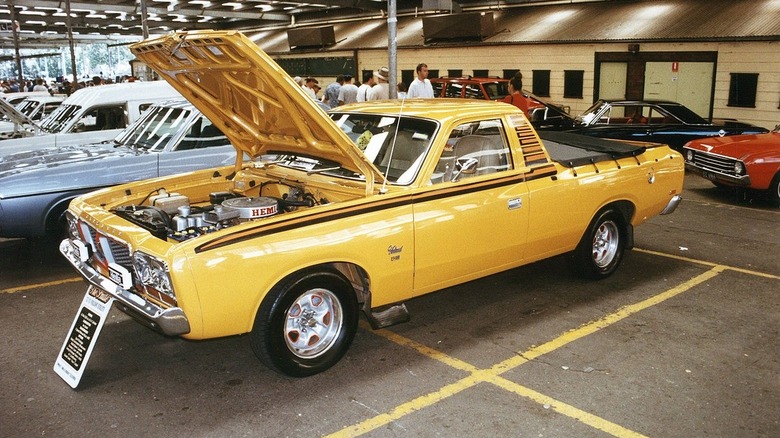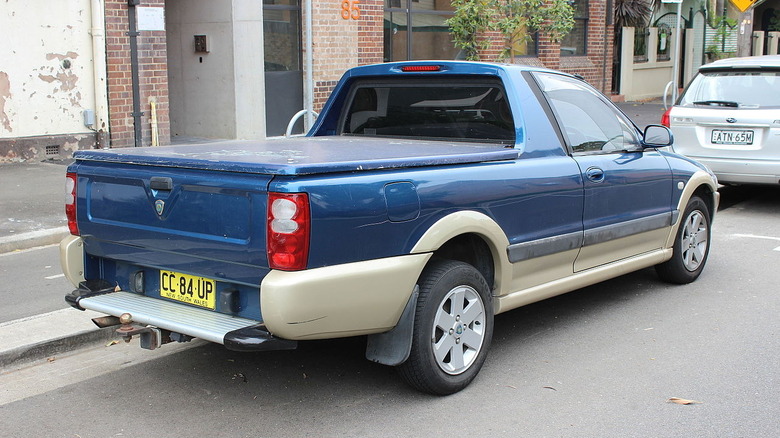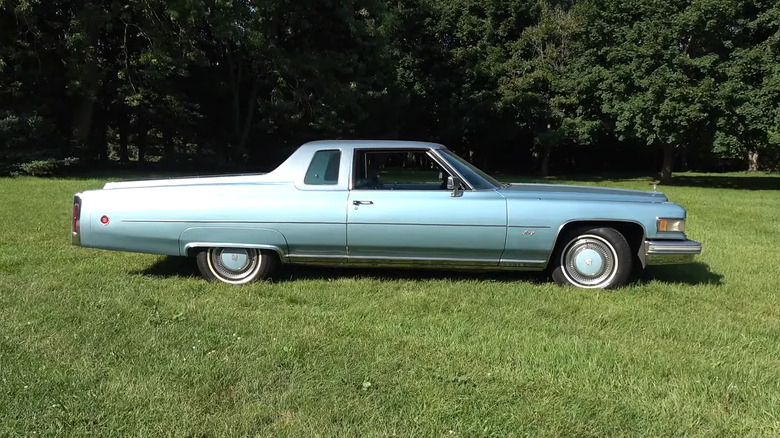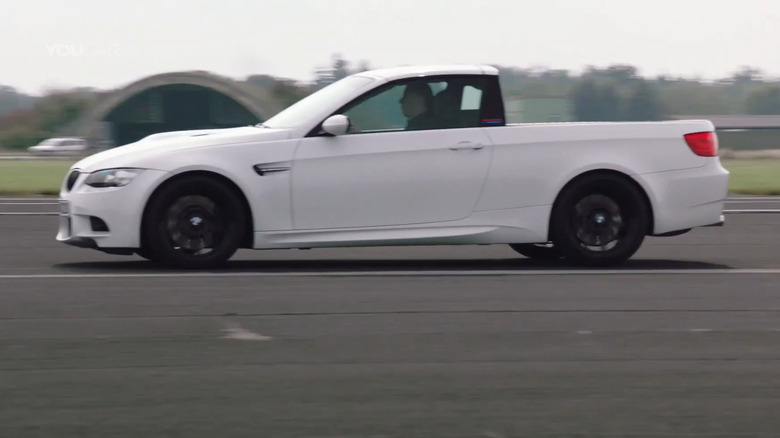12 Weird Classic Cars With Truck Beds
The average dimensions of a full-sized truck are enough to make many tank drivers blanch. Mid-sized pickup trucks have grown larger over the years too — some of the latest ones have even grown beyond the full-sized trucks of yesteryear.
Today's pickup trucks are nothing short of roadway leviathans, but in the not-too-distant past, drivers had an alternative option: a car chassis combined with a truck bed. Despite being probably the most sensible and ambitious crossover in automotive history, they were far from common. However, they weren't exactly rare, either.
Though the car/truck hybrid has fallen by the wayside in favor of recent automotive trends, the curiosities still dot the landscape of automotive history. From the iconic Chevrolet El Camino to the tragically misnamed Suzuki Mighty Boy, lets take a cruise down the memory superhighway and unearth some of the weirdest and most classic car/truck combos that ever made it to market.
Ford Coupe Ute
At the dawn of the pickup truck, the distinction between a car and a truck was blurred. Early automobiles were so basic that there just weren't many differences between passenger vehicles and ones for hauling goods. The Ford Model T pickup bore a striking resemblance to its passenger counterpart, and it played a significant role in the evolution of car/truck hybrids. However, the true car/truck hybrid first emerged from Australia in the 1930s.
Australia, with its proud history of "utes" (short for utility vehicles), was the birthplace of a vehicle that combined the best qualities of a car and a pickup, catering to the needs of rural families. The impetus was a letter received by Ford Australia in 1933 from a rural housewife who requested a vehicle "we can use to go to church on Sunday... and use to take the pigs to market on Monday."
Designer Lew Bandt took the woman's request to heart and set out to bring her vision to life. The result was the coupe utility vehicle pictured above, essentially a five-window Ford coupe with a steel pickup bed instead of rear seats. The vehicle became a hit in Australia, with over 20,000 units sold between 1940 and 1954, and marked the beginning of this particular automotive niche. The ute formula spread around the world, bringing forth samples from several car-producing nations, each with its own twist on a combination as classic as hamburgers and french fries.
Armstrong Siddeley Whitley 18
Henry Ford introduced the term pickup truck to the American lexicon with the Model T, and Australians brought us the ute with a five-window coupe, but Ford wasn't the only brand fiddling with the configuration.
In 1909, Brit John Siddely managed the Deasy Motor Company in Coventry, England. By 1915, his name was on the marquee, and the Siddeley Deasy partnership got a contract to build aircraft. Throughout the 20th century, Siddely's name would be attached to all sorts of projects, including building the overlooked WWII Hawker Hurricane fighter aircraft, but we're more interested in the Armstrong Siddeley Whitley 18.
Armstrong Siddely was known for its production of luxury automobiles alongside its aero products. The first car designed by Siddley was a 30 hp model, joined by two smaller siblings boasting 14 and 18 hp.
Produced between 1949 and 1953, the Armstrong Siddely Whitley 18 featured a variation with a barely-there truck bed mounted behind a gargantuan, curving cockpit that overshadowed the extra cargo space in the back. Powered by a 2.3-liter in-line six-cylinder that somehow only managed 18 hp, the Siddely may not have been a speed demon, but its unique design earns it a spot on our list of classic cars with a little extra in the back.
Austin A40
The Austin name may be most famous for the popular Austin-Healey sports cars of the 1950s and 1960s, but its august history extends back to the earliest years of mass-produced vehicles. Founded by British-born Herbert Austin in 1905, the automaker had decades of experience under its belt before putting forth the A40 car/truck hybrid.
By the mid-1940s, Austin needed an update to its underpowered Eight, Ten, and Twelve models (each name represents the amount of horsepower under the hood). The 1947 Austin A40 Devon arrived as a four-door sedan paired with a two-door version coined the A40 Dorset.
With a whopping 40 horses tugging at the reins, Austin upped the utility of the Dorset by replacing the rear with a pickup bed. At a glance, its tricky to tell that this thing started as a standard car. The body design trends of the time make it look like a classic pickup, but the design process places it squarely in the car/truck hybrid category.
The pickup edition ceased production in 1956, while the A40 carried on for another decade before getting the axe in 1967.
Subaru Brat
There's nothing like a terrible reverse-engineered acronym, and Subaru took it to the limit with the Bi-Drive Recreational All-terrain Transporter. Subaru carved a niche for itself in the market by building plucky little transporters with a reputation for off-road capability, and the Brat sits square in that category.
The bi-drive indicated a part-time all-wheel-drive system mated to a 1.6- or 1.8-liter four-cylinder version of Subaru's preferred boxer engine configuration. With a power output between 67 and 95 hp (depending on the year), the Brat wasn't about to win any tractor pulls. Still, the two-seater with the pickup bed has a style all its own.
Built for export only, it roamed the roads of Europe, Latin America, Oceania, and North America, but not all markets got to call it the Brat. Its aliases include the Targa, Shifter, MV, and Brumby.
The United States imported the Brat from its debut in 1979 until 1987, but other markets enjoyed it until it finally ceased production in 1994. The Brat might have a cringeworthy name, but there's no denying it has a style all its own.
Suzuki Mighty Boy
Speaking of Japanese exports with oddball names, Suzuki got in on the car/pickup action with the not-so-mighty Mighty Boy. With an eye to sparking manufacturing in the wake of the Second World War, the Japanese Ministry of International Trade and Industry decreed tax breaks and reduced registration fees would be rewarded to those who drove vehicles under a certain size and displacement.
The kei car (short for kei jidosha, or light vehicle) took Japan by storm, and kei trucks followed. Japanese manufacturer Suzuki dove head-first into building cars and trucks that met these standards.
The Suzuki Mighty Boy was a unique addition to the kei car family, debuting in 1983. It was equipped with an in-line-three engine that produced 30 hp. The most striking feature of this vehicle was its compact size, with a truck bed smaller than the cockpit and hood combined. While it may not have been suitable for farming or industrial construction, it excelled in navigating the narrow urban streets of Japan with a decent amount of cargo space in its bed.
Suzuki exported the Mighty Boy to Australia and Cyprus, but it died an early death in 1988, after only five years of production.
Chevrolet El Camino
No list of classic cars with truck beds is complete without the Chevrolet El Camino. Possibly the most famous car/truck hybrid of all time, the El Camino isn't just a curiosity; it's a bonafide classic.
The first El Camino appeared for the 1959 model year as part of a trend that saw trucks turn from completely utilitarian vehicles to more comfortable experiences suitable for daily driving. It followed the Ford Ranchero, which debuted two years prior. The first-gen El Camino didn't last; Chevrolet killed it after 1960, only to bring it back in 1964.
Throughout the following years, Chevrolet poured resources into its El Camino. It achieved the height of its icon status in the third generation, built between 1968 and 1972. Despite the truck bed, the third-gen El Camino is counted among the most legendary muscle cars ever. The 1970 SS edition got the same 454 cubic inch big-block V8 engine found in the Chevelle.
Though most often remembered from its muscle era, the El Camino lasted another 17 years before Chevrolet put out the final iteration in 1987.
The El Camino may be the most famous car-truck hybrid ever, and with good reason.
Ford Ranchero
The Ford Ranchero gets short shrift in the annals of American car/truck hybrids. Outshone by the El Camino, it pre-dated its Chevy competitor by two model years.
Advertised somewhat disingenuously as "a new idea in motor vehicles," the Ranchero concept came from Australian designer Lew Brandt, who as we mentioned earlier designed the Ute. Clearly the car's success in Australia clued the Ford company into the possibility that the configuration might find traction in the United States.
Ford brought the recipe to North America in 1957, building the Ranchero on a station wagon chassis. The first generation offered 3.6-, 4.8-, and 5.8-liter engines. By 1960, Ford switched the base of the Ranchero to the more compact Falcon chassis.
The second generation's five years of production would prove to be the longest in the Ranchero's history. Ford continually tweaked the design, resulting in seven generations lasting as little as the single-year run of the third generation between 1966 and 1967. Ford ended the Ranchero in 1979, eight years before its sister El Camino went to the chopping block.
Chevrolet SSR
There was a strange period in the late-'90s and early-'00s when American car companies turned to 1930s car design. Remember the Plymouth Prowler, the open-wheel two-seater roadster no one asked for? After watching Chrysler shoot itself in the foot with its ill-conceived throwback, Chevrolet decided to try something similar.
The resulting Chevrolet SSR occupied the center space in a Venn diagram that included '30s pickup styling, a car-like cockpit, and a V8 engine. The two-seater roadster pickup had a Vortec V8 making 300 hp and could hit 60 mph in under 8 seconds and pull a 15-second quarter mile — respectable numbers for the time. It was polarizing, to say the least.
The SSR's limited passenger capacity and high price of around $41,000 ($70,000 in 2025) confounded the market. It was too expensive to beat up on a job site and too car-like to be much good as a truck — and you couldn't take more than one passenger. That might explain why Chevy only built it for three years between 2003 and 2006.
The SSR's price on the used market reflects its reception. With an average used value of $28,000, it has not yet turned into the future classic Chevy undoubtedly hoped it would be.
Chrysler Valiant Ute
Not to be outdone by Ford and GM, Chrysler also dipped a toe in the car/truck hybrid pool. With Ford and Chevy hogging all the fun in the American market with the Ranchero and El Camino, Chrysler turned to Australia, a country known for its love of utility vehicles, to stretch its car/truck hybrid wings.
Based on the Plymouth Valiant, the Chrysler Valiant Ute never arrived in the American market, but the Aussies ran away with the concept. Debuting as the Valiant Wayfarer Utility in 1965 with a production run of 4,500, the originals are exceedingly rare.
Chrysler went on to build thousands more of the car/truck hybrid, with nearly 15,000 emerging from assembly lines in the mid-1970s. Chrysler never brought the Valiant Ute to North America, so if you see one on the road or rusting away in a junkyard in the States, someone took the time and expense to import it.
Proton Jumbuck
Australia's neighbor Malaysia jumped into the ute game in the 2000s, gifting humanity the divinely named Proton Jumbuck.
The Malaysia-based auto producer enjoyed a professional relationship with Mitsubishi when it debuted the Jumbuck in 2002. Based on the fourth-generation Mitsubishi Lancer rally car platform, the Jumbuck was a compact car/truck hybrid with a capacity for two passengers and a pickup bed big enough for most contracting needs.
With a 1.5-liter engine built by Mitsubishi, the Jumbuck boasted 85 hp. It was small and practical, but it qualified as a utility vehicle in nations where those types of cars received tax and fee benefits. Unlike the big American hybrids, the Jumbuck counts the Subaru Brat and Suzuki Mighty Boy amongst its spiritual brethren.
Proton built the Jumbuck between 2002 and 2011, exporting them to the United Kingdom, Taiwan, and (surprise, surprise) Australia. That dream ended after it scored a one-star crash test rating in Australasian New Car Assessment Program tests.
Cadillac Mirage
It's a little-known fact that America's foremost luxury brand, Cadillac, once dabbled in the world of car/truck hybrids. The Cadillac Mirage came and went so swiftly, it's almost as if it was a mirage itself.
In 1975, the car/truck hybrid trend was in full swing in America. With Ford and Chevrolet all over the market, where were the car/trucks for the wealthy? Famed custom coach builder Gene Winfield resolved to ameliorate this tragic oversight. His solution was to take a 1975 Cadillac Coupe de Ville with its 130-inch wheelbase and convert it to a car with a pickup bed. Whatever fever dream inspired Cadillac to allow this has been lost to history, but we're glad it happened.
With a design by Winfield, Traditional Coach Works in Chatsworth, California built over 200 of these mutants with Cadillac's blessing. The conversion alone cost $9,000 ($53,000 in 2025). Considering the original base MSRP of the car was $8,600, whoever wanted a pickup Cadillac needed to really want it to shell out the kind of cash. Traditional Coach Works produced these behemoths out of 1975 and 1976 model Coupe de Villes, after which the Mirage went the way of the dodo.
BMW M3 Pickup
This one is a real eyebrow-raiser. BMW is known for many things, but pickup trucks are not among them. And yet, the European automaker built a pair of pickup trucks based on its well-regarded cars.
In 2011, BMW tasked its graduate trainers and apprentices with building a pickup truck prototype. BMW took an E30 convertible, put a truck bed on the back, and installed an M3 powertrain.
With the M3 Coupe, M3 Convertible, and M3 Sedan in the works, BMW revealed the fourth iteration of its sporty platform, the M3 pickup on April 1, 2011. The reveal of the pickup rocked the car world, leading pundits and journalists to wonder if this was some sort of April Fools joke.
It was; the joke was on us. BMW was having a bit of fun. The M3 pickup was never intended for production, but the two prototypes that emerged from this playful prank were met with surprisingly positive reviews. Those fortunate enough to drive one found them to be a thrilling and unique addition to the BMW lineup.
